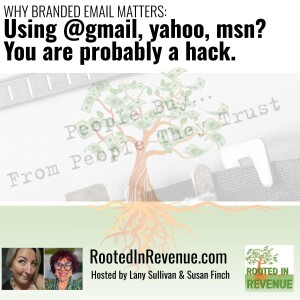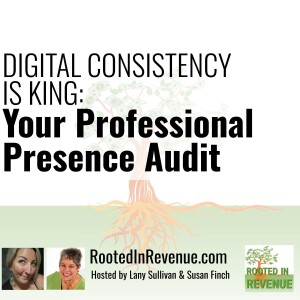Rooted In Revenue
Personal Brand
Episodes

Wednesday Oct 29, 2025
You Earned It, Now Flaunt It: Marketing Your New Professional Designation
Wednesday Oct 29, 2025
Wednesday Oct 29, 2025
You earned that certification. Now what?
If you're like most professionals, you invested time and money into leveling up your expertise... only to let that shiny new credential sit quietly in your inbox, in your bank statement, rather than on your LinkedIn profile. Sound familiar?
In this episode of Rooted in Revenue, I'm sharing the exact 14-day launch plan I use with clients to transform professional certifications into credibility, conversations, and clients.
What you'll learn:
Why the first 48 hours after certification are critical (and what to update first)
The "badge reality check" that could be killing your credibility
How one announcement postcard generated 10 quality conversations
The LinkedIn "position hack" that notifies your entire network
A complete checklist to implement in just 2 hours
Whether you just completed training, earned a designation, or achieved any professional milestone, this episode gives you the roadmap to maximize your ROI.
Episode highlights:
[2:00] The trust signal you're not using effectively
[5:00] Why print marketing still works in 2025
[8:00] Your 14-day certification launch plan
[10:00] The part-time position trick for LinkedIn visibility
Stop letting your credentials collect dust. It's time to make them work as hard as you did to earn them.

Wednesday May 07, 2025
Your Email Is Your First Impression – Why Branded Email Matters
Wednesday May 07, 2025
Wednesday May 07, 2025
In this episode, Susan Finch and Lany Sullivan revisit a topic we can’t stress enough: branded email addresses. Using Gmail, Yahoo, or even AOL for business? You’re losing trust before the conversation starts. We dig into real examples, onboarding requirements, offboarding protocols, and the risk of letting your team operate with inconsistent or unprotected emails. Your email isn’t just a communication tool—it’s your brand's handshake.
Related Reading:
Domain, Email & Website Evaluation for Your Brand
Why Branded Email Matters – Quick Reminder
Listen, nod, then take action.

Thursday May 01, 2025
Data That Matters: Creating Impactful Real Estate Marketing Visuals
Thursday May 01, 2025
Thursday May 01, 2025
Struggling to make your real estate data stand out in a sea of generic market reports? In this episode of Rooted in Revenue, I share practical insights from my recent workshop with NRBA professionals Kelley Kesterson and Angelica Suarez, who are looking to elevate their marketing with meaningful data visualization. Discover how to transform complex market statistics into compelling visual stories that build trust and position you as the go-to expert in your local market—all using tools you already have access to, like Google Sheets. Stop wasting time on generic industry charts that mean nothing to your audience and start creating content that genuinely connects.
Key Points
Data with context builds trust - Generic industry charts without local relevance or explanation provide no value to your audience.
Simplify your data storytelling - Focus on communicating one clear message rather than overwhelming with multiple data points.
Use accessible tools - Google Sheets offers easy chart creation and customization without needing advanced design skills.
Brand your visuals - Customize colors to match your brand and include your logo so graphics remain attributed if shared.
Create master templates - Develop Google Slides masters with different layouts for different content types to maintain consistency.
Prioritize readability - Use high contrast between text and background, and consider accessibility for all viewers.
Post with purpose - Better to post quality content weekly than generic, contextless daily updates.
Establish visual consistency - Different content types should have recognizable, consistent layouts.
Consider format versatility - Create both square (Instagram) and rectangular (website/LinkedIn) versions of your template.
Show local expertise - Position yourself as the authority by translating national trends to your specific market conditions.

Monday Feb 17, 2025
Jolene, Fonts, and First Impressions: What’s in a Typeface?
Monday Feb 17, 2025
Monday Feb 17, 2025
Imagine Dolly Parton’s Jolene. Now, imagine Miley Cyrus singing it. It's the same song and the same lyrics—but they feel completely different, right? That’s exactly how typefaces work.
A typeface sets the tone before a single word is read. It tells your audience who you are—before they even realize it. And whether your brand feels classic and trustworthy like Dolly’s Jolene or bold and modern like Miley’s version depends on the choices you make in your typography.”
Today, we’re diving into the world of fonts, branding, and first impressions. We’ll break down:
The difference between a typeface and a font (spoiler: Jolene analogy included 🎶).
Serif vs. sans serif and why your logo doesn’t need to match your website font—but should still make sense together.
Why your brand’s typography needs to be readable, tiny, embroidered, or even on a highway sign (because, trust me, it matters).
And, most importantly, what your font choices say about your brand—before your audience reads a single word.
💡 And hey, if you’re near a logo, a sign, or a package right now, take a look—what does its typeface say to you?

Tuesday Nov 12, 2024
Digital Consistency is King: Your Professional Presence Audit
Tuesday Nov 12, 2024
Tuesday Nov 12, 2024
Today, we're challenging you to conduct a Professional Presence Audit—a critical look at how you appear across the digital landscape to ensure your professional image remains consistent, current, and compelling. This is Part 2 of our Digital Brand Checkup series on Rooted in Revenue. Our last episode covered the essentials of managing your digital real estate—from domains to infrastructure.
Essential action items from this episode:
Google Audit:
Search yourself/company in an incognito window
Review up to page 8 of the search results
Document outdated or incorrect listings
Look for unauthorized or outdated profiles
NAP (Name, Address, Phone) Consistency:
Ensure the company name format is identical across all platforms
Standardize address formatting (abbreviations, punctuation)
Use consistent phone number format (preferably with hyphens)
Document the exact format to be used by all team members
Professional Profile Management:
Review all directory listings (industry, membership groups, associations)
Update bios across all platforms
Verify current memberships and certifications
Remove or update outdated affiliations
Create platform-specific bios for different purposes
Website and Landing Pages:
Create specific landing pages for different audiences/purposes
Ensure all domain redirects lead to valuable content
Update professional credentials and certifications
Review and refresh all bio pages
Call-to-Action Consistency:
Define 1-2 primary destinations for all profile links
Maintain consistent messaging across platforms
Ensure all CTAs lead to current, working pages
Document preferred CTAs in your asset depot
Bio Management:
Create a master bio document with variations
Include links to where each bio appears
Update bios to reflect current focus and achievements
Have others review bios for clarity and impact
Consider professional help for bio writing/updating
Documentation:
Create an "Asset Depot" to store all digital presence information
Document all profile locations and login credentials
Please keep track of all bio variations and their purposes
Set up regular review schedules (quarterly/annual)
Regular Maintenance:
Schedule annual comprehensive audits
Set quarterly review reminders
Update profiles when significant changes occur
Regularly test all links and redirects
Remember to resist the urge to use AI for writing bios. While it can help with organization and redundancy checking, your authentic voice and personality should shine through in your professional profiles.

Wednesday Oct 02, 2024
The Power of Reflection: Leveraging Your Past for Future Success
Wednesday Oct 02, 2024
Wednesday Oct 02, 2024
Rediscovering your forgotten skills and experiences can be a game-changer for personal and professional growth. In this insightful episode of Rooted in Revenue, Lany and Susan dive deep into the importance of reflecting on your past accomplishments and leveraging them for future success. They share personal anecdotes, practical tips, and actionable strategies to help you uncover hidden talents and capitalize on your unique experiences.
We dare you to go through this list:
Reflect on past experiences and skills you may have forgotten about
Review old resumes and portfolios
Ask family, friends, and former colleagues about your strengths
Update your professional profiles and resumes regularly
Share stories about your past experiences and skills
Reconnect with old contacts and mentors
Create one-page case studies for your accomplishments
Record video or audio of yourself telling your stories
Identify pivotal moments in your life and career
Look back at all your jobs, even early ones, for valuable experiences
Share your reflections on social media and tag Lany and Susan